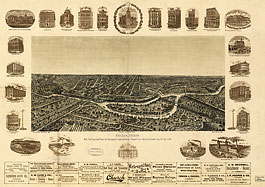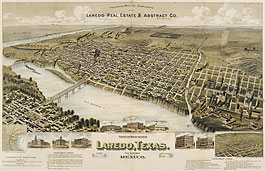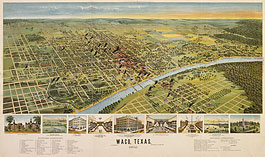Dallas in 1892
By 1892, Dallas had had rail service for twenty years, time enough to witness the often-repeated practice of railroads lowering their freight rates to drive river transportation out of business, then raising the rates again. Not that Dallas ever had effective river transportation, but community leaders had tried several times, beginning in the 1840s, to get Congress to provide federal funds for the improvement of the Trinity River. When… [More]
Laredo in 1892
The railroads brought prosperity and new settlers to Laredo when they arrived in 1881, and the city grew from an 1880 population of 3,521 to 11,319 in 1890. But instead of focusing on the railroads, as many other bird’s-eye-view artists had done, Henry Wellge emphasized the results of the railroads, which had turned Laredo into a growing city and the gateway to Mexico. The Texas Mexican Railway linked Laredo… [More]
Waco in 1892
Although Waco was only the sixth largest city in the state in population in 1892—behind San Antonio, Dallas, Houston, Galveston, and Austin—it had grown to be one of the most important cotton markets in the South. According to one estimate, nearby farmers brought more than 40,000 bales of cotton to Waco to be ginned, and railroads brought another 80,000 bales from smaller cities that did not have their own… [More]













